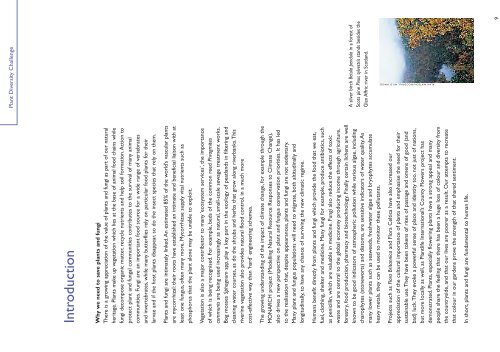Plant Diversity Challenge - Plantlife
Plant Diversity Challenge - Plantlife
Plant Diversity Challenge - Plantlife
Create successful ePaper yourself
Turn your PDF publications into a flip-book with our unique Google optimized e-Paper software.
IntroductionWhy we need to save plants and fungiThere is a growing appreciation of the value of plants and fungi as part of our naturalheritage. <strong>Plant</strong>s make up vegetation which lies at the base of animal food chains whilefungi decompose organic matter, recycle nutrients and help soil formation.Action toprotect plant and fungal communities contributes to the survival of many animalcommunities. Fungi are an important food source for a wide range of vertebratesand invertebrates, while many butterflies rely on particular food plants for theirlarvae and if the host plants disappear, so do the insect species that rely on them.<strong>Plant</strong> <strong>Diversity</strong> <strong>Challenge</strong><strong>Plant</strong>s and fungi are intimately linked.An estimated 85% of the world’s vascular plantsare mycorrhizal: their roots have established an intimate and beneficial liaison with atleast one fungus, often many more. Mycorrhizae supply vital nutrients such asphosphorus that the plant alone may be unable to exploit.Vegetation is also a major contributor to many ‘ecosystem services’, the importanceof which is being recognised. For example, beds of the common reed Phragmitescommunis are being used increasingly as natural, small-scale sewage treatment works.Bog mosses Sphagnum spp. play a key part in the ecology of peatlands in filtering andcleaning water courses, as do the shrubs and herbs that grow along riverbanks.Thisriverine vegetation also provides natural flood control, in a much morecost-effective way than ‘hard’ engineering schemes.The growing understanding of the impact of climate change, for example through theMONARCH project (Modelling Natural Resource Responses to Climate Change),also drives a new perspective on plant and fungus conservation priorities. It has ledto the realisation that, despite appearances, plants and fungi are not sedentary.Many plant and fungus populations will need to migrate, both altitudinally andlongitudinally, to have any chance of surviving the new climatic regime.Humans benefit directly from plants and fungi which provide the food that we eat,fuel, clothing, shelter and medicine. Many fungi for example, produce antibiotics, suchas penicillin, which are valuable in medicine. Fungi also reduce the effects of toxicwaste and are central to the global economy producing income through agriculture,forestry, food production, pharmacy and biotechnology. Finally certain lichens are wellknown to be good indicators of atmospheric pollution while various algae, includingcharophytes (stoneworts) and diatoms, are sensitive indicators of water quality.Asmany lower plants such as seaweeds, freshwater algae and bryophytes accumulateheavy metals, they can be used to monitor these pollutants.Projects such as Flora Britannica and Flora Celtica have also increased ourappreciation of the cultural importance of plants and emphasise the need for theirsustainable use.They have been tokens of rites of passage and omens of good (andbad) luck.They evoke a powerful sense of place and identity too, not just of nations,but more locally as well, as <strong>Plant</strong>life International’s County Flowers project hasdemonstrated. <strong>Plant</strong>s, especially flowering plants have a strong appeal and manypeople share the feeling that there has been a huge loss of colour and diversity fromthe countryside, and that our lives are poorer as a result. Our attempts to recreatethat colour in our gardens prove the strength of that shared sentiment.A silver birch Betula pendula in a forest ofScots pine Pinus sylvestris stands besides theGlen Affric river in Scotland.ALAN WATSON/WOODFALL WILD IMAGESIn short, plants and fungi are fundamental to human life.9
















